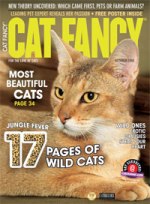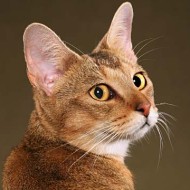
Chausie – Photo of Keetah from the Willowind Cattery © Helmi Flick
| The photos below are thumbnails – click on them for lager images. They are all copyright Helmi Flick – please respect copyright. | |||
 |  |  |  |
Referring to the photographs above the middle two are of Willowind Mafi Mushkla, Mafi for short, from the Willowind cattery (link to cattery at base of page)
Introduction
The Chausie is a hybridization of the Jungle Cat and the domestic cat (usually Abyssinian) – see wildcat hybrids. The jungle cat resembles a small Lynx and is also called the “Swamp Lynx”. It is a medium-small wild cat living in places such as Egypt, Asia, India and Sri Lanka, living off small animals such has rodents and frogs much like the Serval. The name “Chausie” comes from the Latin name for the jungle cat, “felis Chaus“. An early alternative name for this cat breed was the Nile Cat. Incidentally, a new, unconnected breed is being created, at Oct. 2010, called the Nile Valley Egyptian Cat.
All wild/domestic cat hybrid breeding programs have this as an objective. Other examples of this kind of hybrid are the Savannah and the Bengal. They were first bred in the 1960s to 1970s as an alternative to living with a wild Jungle Cat. The breed is registered with TICA under Advanced New Breed (at 2008).
This cat breed is not that rare by my calculation falling at about 6 out of 10, where 10 is the most rare. There is the same nomenclature with respect to generations from the wild Jungle cat. F1 offspring are first generation and F2 second generation and so on. The same system is used in all wildcat/domestic cat hybrids.
The picture immediately below is of a Chausie that lived with the Flicks. You can also see him jumping in a photo further down on this page. His name is “Wildkatz Bwana Bushwah” (“Bushwah” for short). The objective of the breeding program is to produce a combination of the wild look of the jungle cat with the friendly domesticated behavior of the domestic cat.

Chausie cat – photo © Helmi Flick
The Wikipedia authors say that, “Digestive tract problems have been occasionally associated with this breed“. They don’t quote an authority for that, however. They suggest that commercial cat food may be unsuitable as it contains gluten – these cats being possibly gluten-intolerant. See raw cat food – homemade cat food, for an alternative. I would doubt this, though. A good balanced diet of high quality commercial cat food, dry and wet, plus some raw will probably suffice. See best dry cat food and best canned cat food. You might like to see, best kitten foodtoo.
Character
When you breed from a wild cat you bring to the new breed some of the wild cat’s attributes. These are invariably: athleticism, intelligence, a high level of activity (mostly in the evening), assertiveness and dog-like behavior (playing fetch and being trainable – train your cat when she is young). For example, they are spectacular jumpers. He can jump up to 6 feet vertically.
This skill comes from the jungle cat who can jump 8 feet vertically to catch flying birds. It’s a bit like a human jumping over a small house. Who says humans are superior to cats? The picture below is of the Flicks’ F1 Chausie, Wildkatz Bwana Bushwah. Helmi says this about the photograph.
“Ken is 6’4″ tall and our Chausie kitten was leaping from a standstill and was four months old at the time. We exhibited him at cat shows in the category of Household Pet in both TICA and CFA since Chausies were not allowed to be shown as a breed in those days. Bushwah attained the title of Supreme Grand Master in TICA”
 |
| Picture showing this cat jumping vertically – photograph copyright Helmi Flick this is a large thumbnail – click on the picture to see more |
Being active this cat requires human input in the form of plenty of play time and space – I am thinking more of the higher filial cats – F1s and F2s. It is commonsense to suggest that these larger and more active cats need special care and facilities in an ideal world.
Like all cats they are OK with children provided some form of supervision is in place and that the child understands how to deal with a domestic cat. It is important for breeders that the cat shows no sign of challenge in recognition that this “wild element” of its character has been bred out.
Color & Body type
The coat colors are the same as for the jungle cat, brown (black), ticked tabby and black silver tipped (grizzled) tabby. The breed standard accepts solid black.
Melanistic means the increase in black or nearly black pigmentation because of the presence of melanin. It is the opposite to albino. See a black Chausie below and glossary of cat terms.
Melanin is a chemical in animals (including humans) and determines human skin color for example.The stripes that are on the kitten’s coat are lost as she becomes an adult except for the legs, face and end of tail. The coat is ticked (this link takes you to an article about Bengal cat coat and explains what ticked means). Or see & read agouti ticked coat.
Bengal breeders are fond of what they call glitter (meaning a coat that glitters). This breed’s version of glitter is “grizzle” (the silver tipped coat variety). Read more about the appearance. Cats of this breed are large and muscular, not cobby (stocky), with a tail slightly shorter than normal (after the jungle cat).
In terms of weight and therefore size this cat breed is, by my assessment, ranked the second largest TICA registered breed. Read more about domestic cat size.

Grizzled Chausie – Silver tipped black Chausie – photo ©copyright Helmi Flick
This is “Shekinah” from Tammy Isaac’s Willowind Cattery in South Texas
| See more of Shekinah and a black Jungle cat on this page: Black Chausie Cat. |
|---|
Please read on to see what Tammy says about the grizzled coat.
History
| Time line | |||
| 1960s | The breed is created | ||
| 1995 | TICA grants foundation status | ||
| 2001 | TICA grants evaluation status | ||
| 2003 | TICA grants advanced new breed status | ||
As you can see there is little information on the early history – I’m working on this.
Comments on Size and Appearance from Tammy Isaacs, a breeder
The cat on the cover of the Cat Fancy magazine is Keetah, from the Willowind Cattery and who is featured on this page.

Photo: © Helmi Flick
Tammy Isaacs of the Willowind Cattery (see link below), who has been a breeder for 5 years says that she has only seen one cat of this breed over 20 lbs. There are 20+ lb cats but they are rare she says. So catteries claiming 30 lb cats may be exaggerating. Based on Tammy’s first hand experience, the authors at Wikipedia have got it wrong as they say that, ”
Chausie males typically weigh about 25 pounds..”.
Tammy makes the point that very few breeders are still breeding F1s which are larger. She says that the average weight of a Chausie is 12-18 lbs, which is still a large cat.
On the subject of the coat Tammy says this: “The grizzled tabbies used to be called silver-tips until…it was changed to grizzled tabby. It is unique to chausies and comes from the jungle cat. It is actually an extension of the agouti gene which results in a patterned black cat with “silver” ticking. The silver bands on the hairs are caused by an absence of pigment. It is such a cool effect. Some have lots of grizzling & others have just a little. Our standard calls for the grizzleds to have the same ticked pattern as the brown ticked tabbies”.
| Below: photos © Helmi Flick. Photo on the left is Willowind Keetah click for beautiful large format photographs | |
 |  |
Breeders
Willowind Cattery – (link broken Feb 2013 sorry) is a small, TICA registered cattery located on the southern Gulf Coast of Texas. Sources:
- http://www.catsinfo.com
- Messybeast
- Wikipedia
- http://www.chausiebreedcommittee.com/


